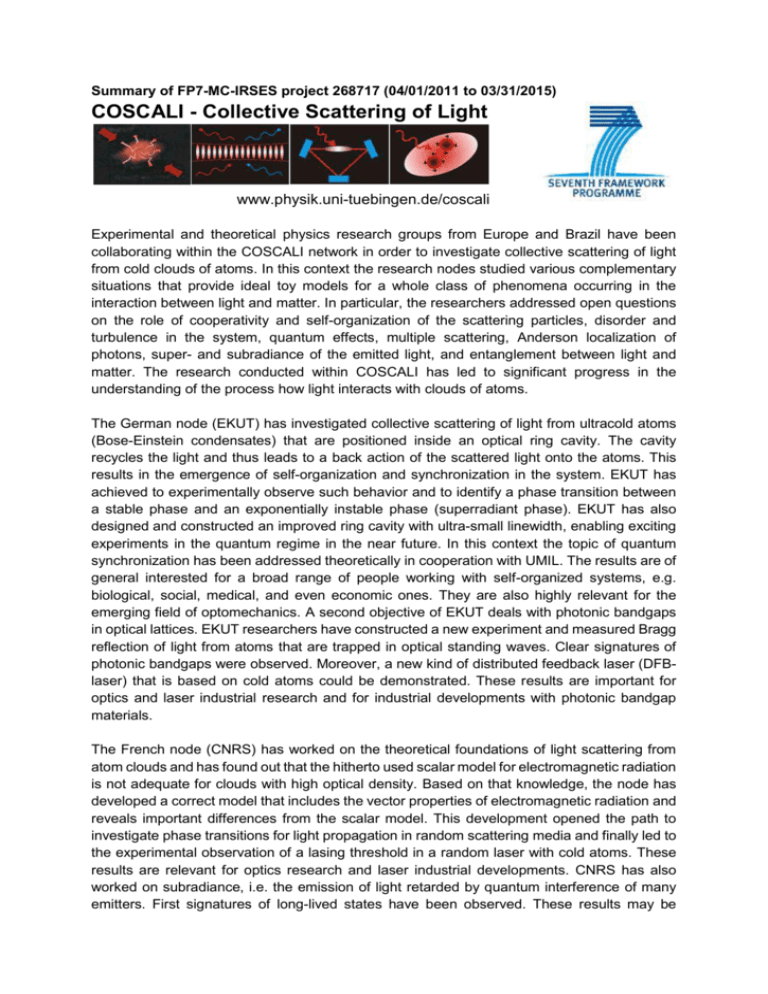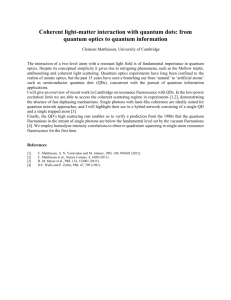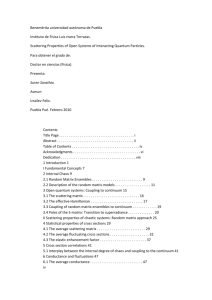final1-publishable-summary
advertisement

Summary of FP7-MC-IRSES project 268717 (04/01/2011 to 03/31/2015) COSCALI - Collective Scattering of Light www.physik.uni-tuebingen.de/coscali Experimental and theoretical physics research groups from Europe and Brazil have been collaborating within the COSCALI network in order to investigate collective scattering of light from cold clouds of atoms. In this context the research nodes studied various complementary situations that provide ideal toy models for a whole class of phenomena occurring in the interaction between light and matter. In particular, the researchers addressed open questions on the role of cooperativity and self-organization of the scattering particles, disorder and turbulence in the system, quantum effects, multiple scattering, Anderson localization of photons, super- and subradiance of the emitted light, and entanglement between light and matter. The research conducted within COSCALI has led to significant progress in the understanding of the process how light interacts with clouds of atoms. The German node (EKUT) has investigated collective scattering of light from ultracold atoms (Bose-Einstein condensates) that are positioned inside an optical ring cavity. The cavity recycles the light and thus leads to a back action of the scattered light onto the atoms. This results in the emergence of self-organization and synchronization in the system. EKUT has achieved to experimentally observe such behavior and to identify a phase transition between a stable phase and an exponentially instable phase (superradiant phase). EKUT has also designed and constructed an improved ring cavity with ultra-small linewidth, enabling exciting experiments in the quantum regime in the near future. In this context the topic of quantum synchronization has been addressed theoretically in cooperation with UMIL. The results are of general interested for a broad range of people working with self-organized systems, e.g. biological, social, medical, and even economic ones. They are also highly relevant for the emerging field of optomechanics. A second objective of EKUT deals with photonic bandgaps in optical lattices. EKUT researchers have constructed a new experiment and measured Bragg reflection of light from atoms that are trapped in optical standing waves. Clear signatures of photonic bandgaps were observed. Moreover, a new kind of distributed feedback laser (DFBlaser) that is based on cold atoms could be demonstrated. These results are important for optics and laser industrial research and for industrial developments with photonic bandgap materials. The French node (CNRS) has worked on the theoretical foundations of light scattering from atom clouds and has found out that the hitherto used scalar model for electromagnetic radiation is not adequate for clouds with high optical density. Based on that knowledge, the node has developed a correct model that includes the vector properties of electromagnetic radiation and reveals important differences from the scalar model. This development opened the path to investigate phase transitions for light propagation in random scattering media and finally led to the experimental observation of a lasing threshold in a random laser with cold atoms. These results are relevant for optics research and laser industrial developments. CNRS has also worked on subradiance, i.e. the emission of light retarded by quantum interference of many emitters. First signatures of long-lived states have been observed. These results may be important for the development of long-lived quantum memories in quantum information technology. Furthermore, CNRS addressed the question if light scattering in cold atom clouds is a suitable test-bed for similar phenomena in plasma- and astrophysics. Several connections could be identified, e.g. radiation trapping and Levy-flights. The Italian node (UMIL) has theoretically addressed the problem of setting up a quantum theory that describes light scattering from cold atom clouds. A matter-wave model was implemented that includes the quantum mechanical motion of the atoms. Using their model UMIL researchers could explain that experimentally observed momentum halos are caused by the atomic recoil due to the scattering of a single photon. They derived also non-classical properties of the scattered light. Furthermore, quantum scattering could be linked to the classical scattering of light from macroscopic objects (Mie scattering). UMIL investigated also strategies for the quantum control of atomic momentum states in optical ring cavities. The theoretical results could be matched with experiments done by EKUT. Moreover, UMIL has worked in collaboration with CNRS on the understanding of subradiance of light from disordered atom clouds and derived how the process depends on experimentally adjustable parameters. This knowledge will help researchers in the future to find suitable parameters for their experiments. The theoretical results are important for a fundamental understanding of light scattering at the edge between quantum mechanics and classical physics and for quantum technology. The Brazilian node (USP) has worked on the turbulent dynamics of vortices in superfluids, i.e. fluids without any friction. The USP researchers succeeded in generating vortices by exerting a non-periodic force on Bose-Einstein condensed cold atom clouds. They developed a theory that explains the observations. USP has also made great progress in the understanding of collective radiation pressure, i.e. the force that light exerts on cold atom clouds by cooperative scattering. The theoretical results could be matched with experimental data from CNRS and EKUT in collaboration with UMIL. Furthermore, USP researchers worked on ideas concerning the synchronization of atomic momentum oscillations by the presence of a ring cavity. This idea has important perspectives for precision measurements of e.g. local gravitation. Within the COSCALI network 43 exchanges between European and Brazilian partners have taken place. The network supported also the participation of early stage researchers (15 exchanges) in order to win highly qualified and mobile workers for the European economy in the future. Annual network meetings with the members of the network and with invited specialists have been organized in France, Germany and Italy. The work within the network has led to completion of 6 PhD theses, and 4 more PhD theses will be finished in 2015. COSCALI has made also efforts towards gender equality with the result that 40% of the PhD students were female, which is a remarkably high value in physics. The results of the work have been published in 29 articles in peer-reviewed journals (among them are highly ranked journals as Nature Physics, Nature Photonics and Physical Review Letters) and in two sections in edited books. Some of the results attracted also the interest of public media and were discussed in press review and radio reports. Contact details COSCALI webpage: www.physik.uni-tuebingen.de/coscali EKUT: Universität Tübingen, Dr. Sebastian Slama, sebastian.slama@uni-tuebingen.de CNRS: Institute nonlinéaire de Nice, Prof. Robin Kaiser, robin.kaiser@inln.cnrs.fr UMIL: Università degli Studi di Milano, Prof. Nicola Piovella, nicola.piovella@mi.infn.it USP: Universidade der Sao Paulo, Prof. Philippe Courteille, philippe.courteille@ifsc.usp.br







